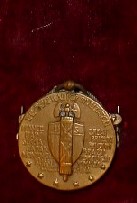


|

|
| Victory Medal Front | Victory Medal Back |
Criteria The World War I Victory Medal was awarded for military service during the First World War. It was awarded for active service between April 6, 1917, and November 11, 1918; for service with the American Expeditionary Forces in European Russia between November 12, 1918, and August 5, 1919; or for service with the American Expeditionary Forces in Siberia between November 23, 1918, and April 1, 1920. Battle Clasps Battle clasps are bronze bars one eighth of an inch high by one and a half inches wide. Each battle clasp contains the name of the campaign (or Defensive Sector). There is a small five-pointed star at each end of the clasp. They were awarded for specific battles or campaigns. The individual must have been present for duty under competent orders in the combat zone during the period in which the unit was engaged in combat. ST MIHIEL (September 12-16, 1918) MEUSE-ARGONNE (September 26 to Nov. 11, 1918) Designer The World War I Victory Medal was designed by James Earl Fraser. Description and Symbolism Obverse In the center of a bronze medallion one and seven-sixteenths inches in diameter, a full-length frontal representation of Winged Victory is shown. She holds a shield in her left hand, and in her right hand she holds a sword. The figure wears a spiked crown. The theme of the obverse was agreed upon by all allied nations, and each country was expected to produce its own rendering of that theme. Winged Victory on the American medal is not only a modern rendering of Nike of Samothrace, it is also Columbia (who also represents America). The spiked crown on her head was suggested by the crown on the Statue of Liberty. Reverse In the center of a bronze medallion one and seven-sixteenths inches in diameter, a shield bearing the letters US (which are separated by a fasces superimposed over the center of the shield and which extends both above and below the shield). In the upper quarter of the medal, following the contour of its edge, the inscription, THE GREAT WAR FOR CIVILIZATION. In the corresponding position along the outer edge of the lower portion of the medal are six stars. To the right of the shield, the names of the following countries: GREAT BRITAIN, BELGIUM, BRAZIL, PORTUGAL, RUMANIA and CHINA. To the left of the shield, FRANCE, ITALY, SERBIA, JAPAN, MONTENEGRO, RUSSIA, and GREECE. The shield is taken from the Great Seal of the United States and represents America, as indicated by the initials on the shield. The fasces represents the lawful authority of the State and justice. The names of the other countries are the Allies who participated in the First World War. Ribbon The ribbon to the World War I Victory Medal consists of a double rainbow, with red joining in the center. The ribbon is edged with narrow stripes of white. The rainbows were selected to represent a "new era" and the calm after a storm (alluding to the First World War). It also represents the combined colors of the Allies joined together in a common cause. The two rainbows also represent the two groupings of nations, Allied and Associated, meeting the heraldic color for conflict and bravery. The use of the double rainbow also provides symmetry and balance and avoids having the ribbon confused with that of the British 1914 Star (which, although not a rainbow, is similar). |